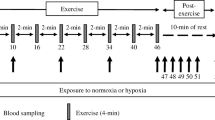Summary
The purpose of this study was to determine the effect of altered metabolic acid-base status on the changes in ventilation in the transition from heavy exercise above anaerobic threshold to rest. Seven subjects ingested, in a randomized and blind manner, either NaHCO3 or CaCO3 (placebo) at a dose of 300 mg · kg−1 body mass and ran on a treadmill for five minutes (90%\(\dot V_{{\text{O}}_{{\text{2max}}} } \) and above anaerobic threshold) on ten different occasions. Changes in minute ventilation in the exercise transitions were studied by starting and stopping the treadmill abruptly with a remote switch. The fast increase in ventilation at the start of exercise was not accompanied by a corresponding fast drop in ventilation at the end of exercise (P≪0.001) and the effects of chemicals on these changes were not significantly different (P<0.05). A single-component exponential model, without a time delay, was used to determine the time constants of off-transitional decay in ventilation for the two chemicals in each subject. Parametric and non-parametric statistical tests revealed that the time constants were not as significantly different as the venous pH measurements which were significantly higher with NaHCO3 (P≪0.001). The results indicate that the absence of fast change in ventilation at the end of heavy exercise is not due to lactic acidosis and the consequent slow ventilatory changes in the off-transition of heavy exercise are at least partly mediated by non-humoral factors such as a central neural reverberatory mechanism.
Similar content being viewed by others

References
Casaburi R, Stremel RW, Whipp BJ, Beaver WL, Wasserman K (1980) Alteration by hyperoxia of ventilatory dynamics during sinusoidal work. J Appl Physiol 48:1083–1091
Cunningham DJC (1967) Regulation of breathing in exercise. Circ Res 20&21, [Suppl] 1:122–131
Cunningham DJC, Lloyd BB, Spurr D (1966) The relationship between the increase in breathing during the first respiratory cycle in exercise and the prevailing background of chemical stimulation. J Physiol (Lond) 185:73P–75P.
D'Angelo E, Torelli G (1971) Neural stimuli increasing respiration during different types of exercise. J Appl Physiol 30:116–121
Dejours P (1957) Intérêt méthodologique de l'étude d'un organisme vivant à la phase initiale de rupture d'un équilibre physiologique. CR Acad Sci (Paris) 245:1946–1948
Dejours P, Lefrancois R, Flandrois R, Teillac A (1960) Autonomie des stimulus ventilatoires oxygène, gaz carbonique et neurogénique de l'exercise musculaire. J Physiol (Paris) 52:63–64
Eldridge FL (1974) Central neural respiratory stimulatory effect of active respiration. J Appl Physiol 37:723–735
Griffiths TL, Henson LC, Huntsman D, Wasserman K, Whipp BJ (1980) The influence of inspired O2 partial pressure on ventilatory and gas exchange kinetics during exercise. J Physiol (Lond) 306:34P
Jeyaranjan R, Goode R, Duffin J (1988) Changes in respiration in the transition from heavy exercise to rest. Eur J Appl Physiol 57:606–610
Jones NL, Sutton JR, Taylor R, Toews CJ (1977) Effect of pH on cardiorespiratory and metabolic responses to exercise. J Appl Physiol 43:959–964
Kelman GR, Nunn JF (1966) Nomograms for correction of blood\(P_{{\text{O}}_{\text{2}} } \),\(P_{{\text{CO}}_{\text{2}} } \), pH and base excess for time and temperature. J Appl Physiol 21:1484–1490
Kowalchuk JM, Heigenhauser GJF, Jones NL (1984) Effect of pH on metabolic and cardiorespiratory responses during progressive exercise. J Appl Physiol 57:1558–1563
Linnarsson D (1974) Dynamics of pulmonary gas exchange and heart rate changes at start and end of exercise. Acta Physiol Scand [Suppl] 415:1–68
Matell G (1963) Time-course of changes in ventilation and arterial gas tensions in man induced by moderate exercise. Acta Physiol Scand [Suppl] 206:1–53
Oren A, Whipp BJ, Wasserman K (1982) Effect of acid-base status on the kinetics of the ventilatory response to moderate exercise. J Appl Physiol 52:1013–1017
Sutton JR, Jones NL, Toews CJ (1981) Effect of pH on muscle glycolysis during exercise. Clin Sci Mol Med 61:331–338
Ward SA, Blesovsky L, Russak S, Ashjian A, Whipp BJ (1987) Chemoreflex modulation of ventilatory dynamics during exercise in humans. J Appl Physiol 63:2001–2007
Wasserman K, Whipp BJ, Casaburi R (1986) Respiratory control during exercise. In: Fishman AP, Cherniack NS, Widdicombe JG (ed) Handbook of physiology, Sect 3. The respiratory system, vol II. American Physiological Society, Bethesda, MD
Whipp BJ, Ward SA, Lamarra N, Davis JA, Wasserman K (1982) Parameters of ventilatory and gas exchange dynamics during exercise. J Appl Physiol 52:1506–1513
Whipp BJ, Wasserman K (1986) Effect of anaerobiosis on the kinetics of O2 uptake during exercise. Fed Proc 45:2942–2947
White DP, Douglas NJ, Pickett CK, Weil JV, Zwillich CW (1983) Sexual influence on the control of breathing. J Appl Physiol 54:874–879
Author information
Authors and Affiliations
Rights and permissions
About this article
Cite this article
Jeyaranjan, R., Goode, R. & Duffin, J. The effect of metabolic acid-base changes on the ventilatory changes at the end of heavy exercise. Europ. J. Appl. Physiol. 58, 405–410 (1989). https://doi.org/10.1007/BF00643517
Accepted:
Issue Date:
DOI: https://doi.org/10.1007/BF00643517



